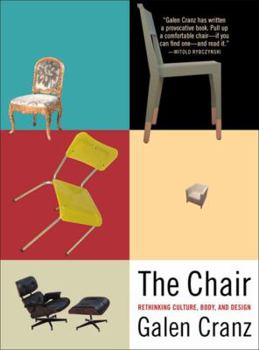The Chair: Rethinking Culture, Body, and Design
Select Format
Select Condition 
Book Overview
Perhaps no other object of our daily environment has had the enduring cultural significance of the ever-present chair, unconsciously yet forcefully shaping the physical and social dimensions of our lives. With over ninety illustrations, this book traces the history of the chair as we know it from its crudest beginnings up through the modern office variety. Drawing on anecdotes, literary references, and famous designs, Galen Cranz documents our ongoing...
Format:Paperback
Language:English
ISBN:0393319555
ISBN13:9780393319552
Release Date:January 2000
Publisher:W. W. Norton & Company
Length:288 Pages
Weight:0.75 lbs.
Dimensions:0.7" x 6.0" x 8.9"
Customer Reviews
5 ratings
Exciting as a novel
Published by Thriftbooks.com User , 24 years ago
I'm delighted with "The Chair" and am telling everyone I talk to about how it is as exciting as a novel to read. Jane Heirich, Alexander teacher
Bringing to life the everyday
Published by Thriftbooks.com User , 24 years ago
Galen Cranz has brought to life an everyday object that is so common we have stopped noticing it. Her insights into the history of the chair and to the effect of current designs upon our bodies wakes the reader up to the intelligence and motives that have gone into the designs that literally have shaped our bodies and changed our experiences. I highly enjoyed this book and the insights that it gave me. Robert Britton
A wonderful read about an unexpected subject.
Published by Thriftbooks.com User , 25 years ago
I never thought I'd be reading a book about chairs! But this book is well worthwhile for anyone who has ever complained about uncomfortable chairs - at work, at home, at the airport etc. The book gives you quite a bit of practical information. I was struck by the references to the Alexander Technique (the author is an Alexander Technique teacher as well as being a university professor) and so I did a little researsch on that topic. There are quite a few good books available and a very comprehensive web site at alexandertechnique.com
This book has inspired me to further research.
Published by Thriftbooks.com User , 25 years ago
This highly original book inspired me to look further into the design of my own work and home spaces. I immediately wanted to try out those Norwegian "perching" work desks (for students) on a classroom, just to get student feedback on them. Alas, that may take years! BTW, where can one order such furniture?
A fascinating challenge to anyone who sits
Published by Thriftbooks.com User , 25 years ago
There are certain subjects that do not seem to lend themselves to serious or interesting scrutiny. I would have said the history of the chair, and its place in society, would have been one of those subjects until reading Professor (and Alexander Teacher) Galen Cranz's new book, The Chair: Rethinking Culture, Body and Design. Professor Cranz takes a look at the history of chairs, their place establishing hierarchical relationships among people, and the various design attempts artists and architects have made at creating chairs. Cranz makes clear in her book that in chair design often the "emphasis is on materials-plastic, metal, and wood in varied applications-rather than on the effect of the chair and its structure upon the body and its structure." The chair becomes an object, an everyday sculpture, that oftentimes disregards the fact that it is being used in particular ways for particular purposes, with substantial impact on the individual who sits in the chair. In recent history, an increasing focus has been made on the way chairs affect our use. For anyone interested in the way we use ourselves, the portion of the book that examines the ergonomic attempts to create a more body-friendly chair reads like a dark comedy, as various attempts are made to address one part of the body, without adequately considering another part. Cranz takes us through this process and helps us see the misconceptions that many designers have built into their chairs. One of the first, and biggest, problems facing designers is figuring out how to determine what would make a chair that facilitated ease and comfort. Comfort is a particularly vexing concept, for reasons obvious to any Alexander teacher, since the old familiar habitual patterns are going to tend to feel comfortable, at least in the short term. Cranz suggests that the various attempts at measuring comfort, including the use of "Electromyogram tests... stresses along the spine, using needles in the discs or pressure-sensitive pills" have been unsuccessful in measuring a meaningful change in comfort level for the person sitting.Another refreshing aspect of the book is the radical notion put forward by a new breed of ergonomic designers that chair design specifically, and workplace design in general, should not be restricted by "traditional cultural expectations. They want to change traditional workplace design. For them, the beginning and end of design should be the body."Cranz gives a short history of the Alexander Technique in her book, but only references the Technique when it is relevant to the general design questions at hand. The Technique is presented as a unique approach that can help inform chair design, without proselytizing about the specific benefits of the Technique itself. The Technique has simply become, in effect, part of the relevant literature on design issues. In one section of the book, Cranz talks about how one's conception of gravity will change one




